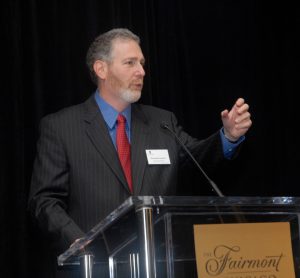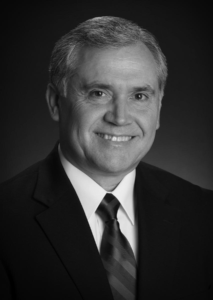
In May, the Environmental Law & Policy Center released a year-long study whose results pointed to confined or concentrated animal feeding operations as a major source of nutrient overload in Lake Erie from the Maumee River watershed.
According to that study, CAFOs have been growing in both number and size of operations during the last decade.
As a follow-up to the CAFOs study, on Sept. 10, ELPC released the results of a poll the group says proves the public would like to see more action taken to curb CAFOs and pollution they may cause.
The poll indicates that while a majority of northwest Ohioans are receptive to stricter government regulations, they’re even more inclined to approve measures after they learn more about CAFOs and their connection to harmful algal blooms on Lake Erie. Five hundred registered voters in Erie, Ottawa, Lucas and Sandusky counties were interviewed in the survey, conducted by Selzer & Company.

Howard Learner, ELPC Executive Director, Photo by elpc.org via flickr.com
“We commissioned the poll so we can better understand the public’s depth of knowledge around the causes of (algal) blooms in Lake Erie and what people know about CAFOs and related manure run-off pollution and whether people are willing to support regulation of CAFOs and how important this is to voters when they make their decisions at the ballot boxes,” said Howard Learner, ELPC executive director.
He went on to say that while commercial fertilizer from corn and soybean operations has gotten expansive press coverage, the manure pollution from CAFOs has mostly flown under the radar.
“Over the past decade, the number of CAFOs has increased by almost 40 percent and the number of animals in the watershed has doubled from 9 million to more than 20 million,” Learner said. “These are not mom-and-pop small farms. These farms have many thousands of chickens, pigs and cows and produce many tons of manure that’s spread on fields and is stored in lagoons, then run into waterways that flow into Lake Erie.”
Learner said under the Great Lakes Water Quality Agreement, phosphorous loading in Lake Erie must be reduced by 40 percent by 2025 and progress made toward reducing it by 20 percent by 2020.
“It’s time that Ohio and Gov. (Mike) DeWine honor that commitment and take the action which polling shows people in northwest Ohio truly want,” Learner implored.
Majority of voters polled in favor of freeze on new CAFOs
Initially voters approved of a freeze on new CAFOs 44 percent to 33 percent, the remaining undecided. But after presented with various reasons to support or oppose a freeze, support rose to 59 percent, with voters opposing a freeze down to 29 percent, the remaining undecided.
The poll found that 40 percent of voters considered this a major issue, with 36 percent considering it a minor issue.
But results also indicated 59 percent would favor a pro-freeze political candidate over a status quo candidate who favored voluntary programs for farmers to reduce manure run-off.
About 69 percent of voters interviewed were unaware whether CAFOs were regulated by the state, and 59 percent favored bringing smaller CAFOs under state regulation.
Agriculture says farmers already follow the rules, plus go the extra mile

Scott Higgins, President, Ohio Livestock Coalition
“Ohio’s livestock and poultry farmers have for years been making investments, developing best nutrient management practices, and putting in place targeted measures to limit runoff from fields of phosphorous and nitrogen from natural manure and fertilizer,” said Scott Higgins, president of the Ohio Livestock Coalition.
According to agriculture officials, thousands of Ohio farmers, including many in northwest Ohio, already participate in dozens of conservation and science-based programs through state and federal agencies specifically working to reduce, mitigate or eliminate nutrients run-off from both commercial and manure fertilizer products.
“This commitment is why Ohio’s major agriculture organizations joined with environmental organizations in working with researchers to benchmark data and best management practices and create a new farmer certification to support healthy waterways in Ohio,” Higgins said. “The Ohio Agriculture Conservation Initiative is building on the extensive work farmers are already doing to protect the environment and manage nutrients.”
According to Higgins, Ohio farmers are doing everything they can to use, and promote, best management practices in their communities.
Most importantly, Higgins said, is that farmers already document their progress in water quality improvements over time and provide that data to scientists.
CAFOs critics want action sooner rather than later

Jeff Reutter, retired Director of Ohio Sea Grant
Jeff Reutter, retired director of Ohio Sea Grant, was a key member of a science team that produced hard numbers for phosphorous-loading targets in 2016.
“With almost 10 years of trying we have seen zero change,” he said. “The worst tributaries to the Great Lakes are the Maumee River and the Sandusky River here in Ohio. The concentration of phosphorous coming out of the Maumee River is 30 times the concentration coming out of the Detroit River.”
Reutter said that more than 85 percent of the phosphorous content in the Maumee is from agricultural run-off, and that 70 to 90 percent of that occurs during the 10 largest storm events each year. In short, he said, voluntary implementation of nutrients-reducing programs isn’t working.
Learner said clean drinking water and a clean Lake Erie are important issues to Ohioans.
“The big picture here and the results are clear. Number one for people is clean, safe drinking water,” Learner said. “And when people learn that one of the reasons (algal) blooms are happening in Lake Erie is due to manure run-off from CAFOs, they want action.”
Featured Image: Hog confinement barn interior, Photo by epa.gov
2 Comments
-
Only 500 people polled why if the farmers worked together and burned the waste from the animals they could have power for themselves and most likly others and No runoff check the farmer in Wisconsin
-
Nearly a half million acres were not planted this year in the WLEB.
Most acres did not receive any fertilizers.
We have one of the largest blooms recorded.
How many municipality waster water discharges have been reported this year?
More than I can count.




